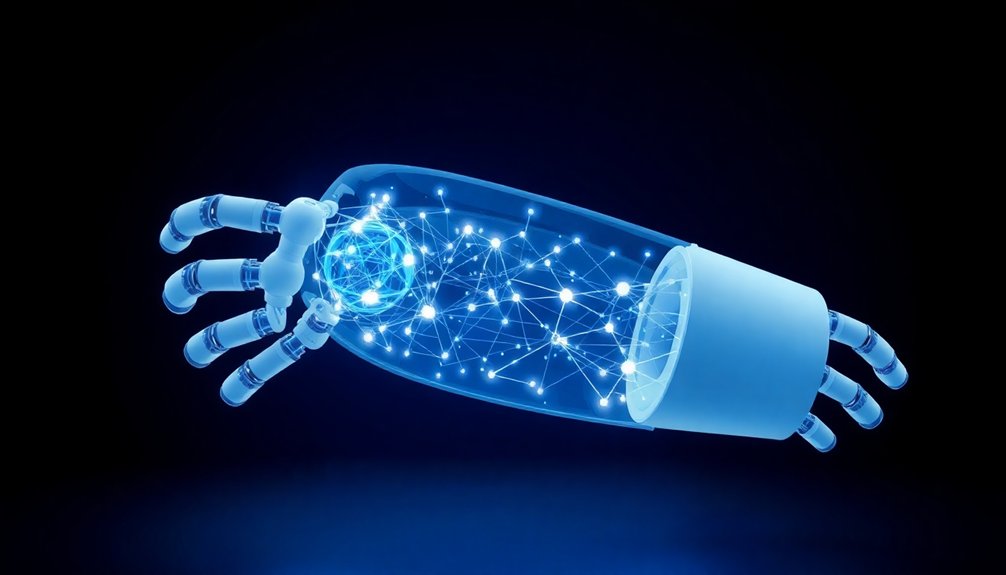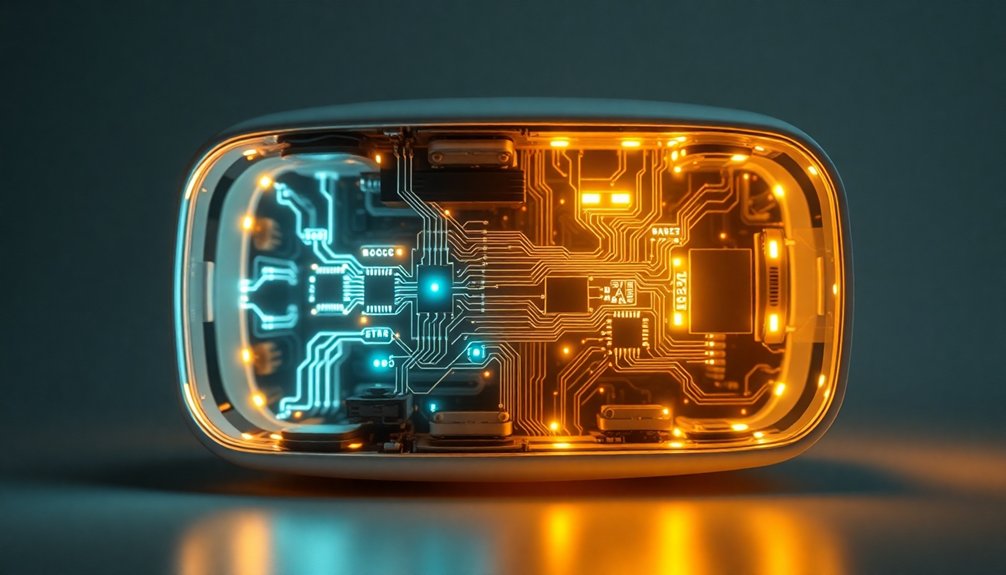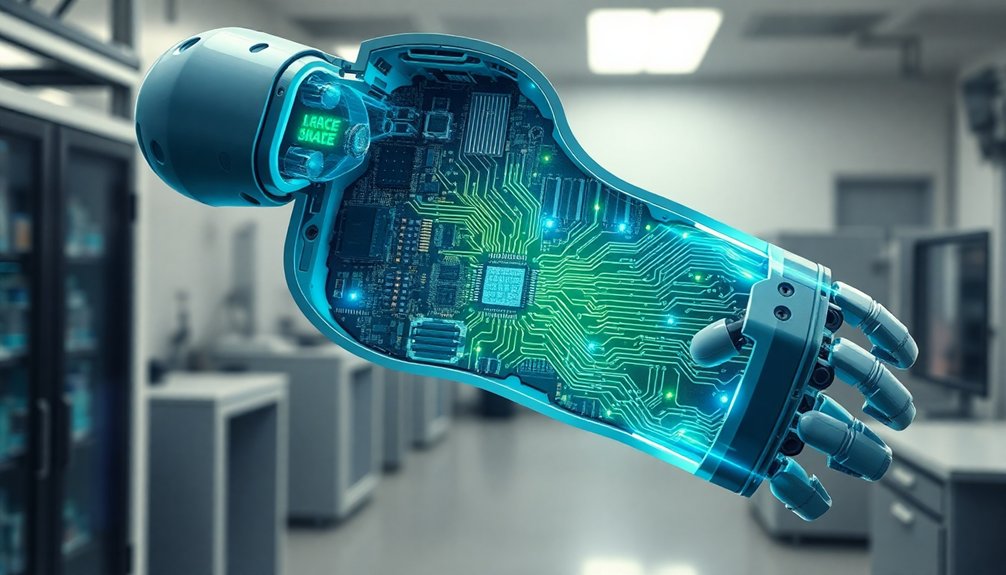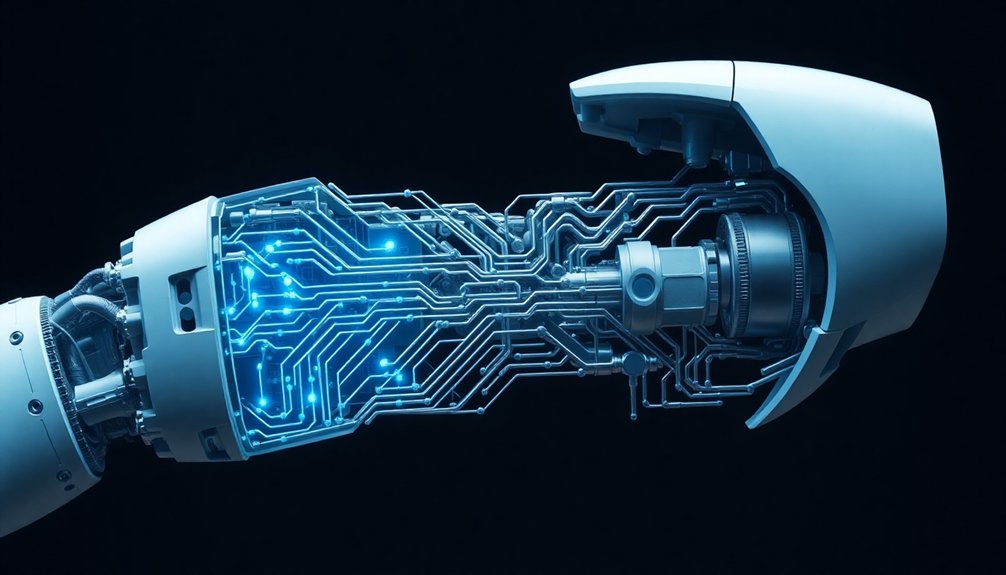Table of Contents
Robot AI is like a brain that learns by gobbling up data and recognizing patterns. Your robot’s neural networks process sensor inputs, crunch numbers faster than you blink, and make split-second decisions. It learns through trial and error, adapting its moves like a digital chameleon. Machine learning lets robots recognize objects, navigate spaces, and solve problems—turning cold metal into something eerily intelligent. Curious how deep this robot rabbit hole goes?
Understanding Machine Learning Fundamentals

While machine learning might sound like sci-fi wizardry, it’s actually the brain behind how robots and AI systems learn and adapt. Regression techniques help machines predict continuous outcomes by analyzing complex datasets. Supervised learning allows algorithms to be trained on labeled data, enabling more precise pattern recognition.
Think of it as teaching a computer to recognize patterns, just like you’d teach a kid to spot shapes in a puzzle. Neuromorphic computing is revolutionizing machine thinking by mimicking brain-like neural networks that can learn and adapt more efficiently. At its core, machine learning is about data – collecting it, analyzing it, and using algorithms to make smart predictions.
Want your robot to navigate a room? Feed it tons of movement data, and it’ll start understanding obstacles like a pro.
The magic happens when these systems start recognizing patterns you didn’t explicitly program. It’s not about memorizing rules, but understanding underlying principles.
Your robot isn’t just following instructions; it’s learning, adapting, and getting smarter with every interaction. Pretty cool, right?
Neural Networks: The Brain of Robotic Intelligence
You’ve heard about AI, but neural networks are where robots really start to get their smarts—think of them as digital brains that learn by mimicking how human neurons connect and communicate. Advanced neural networks can simulate complex computational models that generate synthetic training data, allowing robots to learn without extensive human image labeling.
By creating computational models inspired by biological brain structures, these networks can recognize complex patterns faster than you can blink, turning raw sensor data into meaningful decisions that help robots navigate, identify objects, and respond to their environment. Evolvable neural networks enable robots to develop adaptive controllers that optimize performance through biological-inspired computational strategies.
Want to know how a robot might someday outsmart you? It starts with these brain-like networks that can process information, learn from experience, and adapt in ways that make traditional algorithms look like ancient pocket calculators. Reinforcement learning allows these neural networks to continuously improve their performance through trial-and-error interactions with their environment.
Learning Neural Network Basics
Ever wondered how robots actually “think”? Neural networks are basically digital brains that mimic how humans process information, but way faster and without coffee breaks. Robotic neural systems leverage complex sensor networks that function like a digital nervous system, enabling intelligent movement strategies. These artificial intelligence systems learn through complex patterns, transforming raw data into smart decisions. Convolutional neural networks can analyze visual patterns with incredible precision, allowing robots to interpret and respond to their environment in real-time. GPU architectures enable these networks to process incredibly complex computations by providing thousands of simple processing cores on a single chip.
What makes neural networks so cool? Check out these key features:
- They adapt and learn from experience, like a super-smart toddler with circuit boards
- Each network can process massive amounts of information in milliseconds
- They transform robotic systems from rigid machines into flexible, intelligent performers
Imagine a robot that learns from mistakes, adjusts its behavior, and gets better with every task. That’s not sci-fi — it’s happening right now.
Neural networks are turning robots from predictable automatons into dynamic, responsive machines that can think on their metallic feet. Pretty mind-blowing, right?
Brain-Inspired Computational Models
Because nature’s most sophisticated computer already exists between our ears, robotics engineers are now stealing design blueprints directly from the human brain. Neuromorphic computing platforms like Intel Loihi and IBM TrueNorth are pioneering hardware that can simulate neural circuits with unprecedented efficiency. They’re reverse-engineering neural networks that mimic how we think, move, and learn. Imagine robots that can adapt like humans, using spiking neural networks that simulate brain electricity or deep learning models that copy our mental architecture. These aren’t sci-fi fantasies—they’re happening now. Engineers are building machines that can navigate complex environments, make split-second decisions, and even learn from rewards just like our brains do. Sensorimotor integration enables these advanced robotic systems to coordinate sensory inputs with precise motor outputs, creating more intelligent and responsive machines. Deep reinforcement learning allows robots to evolve through experience, transforming potential into intelligent behavior by continuously improving their decision-making skills.
Pattern Recognition Mechanics
When machines start thinking like brains, something magical happens in the world of robotics. Neural networks transform robots from clunky metal boxes into intelligent companions that can actually understand their environment. How? By mimicking human brain mechanics through interconnected computational nodes. Cognitive engines enable robots to process knowledge in real-time, bridging the gap between algorithmic programming and adaptive intelligence.
These networks do three incredible things:
- Recognize complex patterns in sensor data
- Process visual information like object detection
- Make real-time adaptive decisions
Imagine a robot that learns from experience, just like you do. It’s not science fiction—it’s happening right now. Neural networks let machines interpret the world, turning raw data into meaningful insights. Recurrent Neural Networks enable robots to process sequential data and make decisions based on past experiences, creating a more dynamic and adaptive learning system. Evolutionary algorithms help these networks continuously improve their performance by simulating natural selection processes.
They’re basically the brain’s digital cousins, processing information at lightning speed and adapting instantly.
The future isn’t just about robots doing tasks—it’s about robots understanding context, learning continuously, and becoming genuine problem-solving partners.
Sensor Fusion and Environmental Perception
If robots are going to navigate our world without constantly bumping into things, they’ll need something smarter than a basic set of sensors. Enter sensor fusion: the AI trick that helps robots stitch together different sensor inputs like a high-tech puzzle. Think of it as giving your robot superhuman perception.
| Sensor | Function | Cool Factor |
|---|---|---|
| Camera | Visual Input | 🔥 High |
| LiDAR | Depth Mapping | 🚀 Epic |
| Radar | Motion Tracking | 💡 Smart |
Autonomous Decision-Making Processes

Imagine giving a robot the power to think on its feet—or wheels, or propellers—without constantly checking in with a human supervisor.
Autonomous decision-making isn’t sci-fi anymore; it’s how modern robots navigate complex environments with minimal human input.
Your robot’s brain works through several critical processes:
- Real-time data analysis that processes environmental inputs faster than you can blink
- Machine learning algorithms that continuously refine decision-making strategies
- Predefined rules that act like an internal rulebook for handling unexpected scenarios
These systems allow robots to adapt, predict, and respond in milliseconds.
Whether it’s a self-driving car dodging obstacles or a medical robot performing delicate surgeries, autonomous decision-making transforms how machines interact with the world.
Autonomous machines redefine human-technology interaction, turning complex tasks into precision-driven, intelligent performances.
Think of it as giving your robot a brain that’s part supercomputer, part intuitive genius—without the human ego.
Pattern Recognition and Predictive Analytics
You’ve probably wondered how robots actually learn to recognize stuff without a human constantly pointing and saying “That’s a chair!”
Machine learning patterns are like the robot’s personal training montage, where algorithms gobble up massive datasets and start connecting dots faster than your brain can blink.
Predictive action systems transform these patterns into superhuman anticipation — imagine a robot that can predict a factory machine’s potential breakdown or navigate a disaster zone with split-second tactical insights, all before you’ve even processed what’s happening.
Machine Learning Patterns
Robots are getting smarter, and machine learning is the secret sauce turning them from clunky metal boxes into intuitive problem-solving machines.
They’re not just following programmed instructions anymore; they’re learning, adapting, and making decisions on the fly.
Machine learning patterns help robots:
- Recognize complex environmental signals faster than humans
- Predict maintenance needs before equipment breaks down
- Transform raw sensor data into actionable insights
Your future robotic assistant isn’t just a tool—it’s a learning companion that gets better with every interaction.
Imagine a robot that can diagnose equipment failures, optimize supply chains, and adjust its behavior based on real-time feedback.
Machine learning isn’t science fiction anymore; it’s the brain powering the next generation of intelligent machines.
Who wouldn’t want a sidekick that keeps getting smarter?
Predictive Action Systems
When predictive action systems plunge into robotic intelligence, they’re basically giving machines a crystal ball for problem-solving. By analyzing massive data streams, robots learn to anticipate issues before they happen, like psychic maintenance wizards with circuit boards.
| Sensor Input | Pattern Recognition | Predictive Action |
|---|---|---|
| Raw Data | Anomaly Detection | Proactive Fix |
| Continuous | Statistical Models | Prevent Failure |
| Real-time | Historical Context | Optimize System |
Think of it as teaching robots to play chess with reality—they’re constantly predicting moves, calculating risks, and adapting on the fly. Imagine a robot that knows your industrial equipment’s gonna break down before you do, scheduling maintenance without you lifting a finger. It’s not magic; it’s just really smart algorithms doing their thing, turning potential disasters into smooth, predictable operations.
Training Robots Through Reinforcement Learning

In an era where AI transforms machines from mindless automatons to learning powerhouses, reinforcement learning emerges as the secret sauce making robots smarter than your average silicon sidekick.
Think of it as robot boot camp, where machines learn through epic trial-and-error battles against simulated challenges.
Your future robotic companions will master skills through:
- Reward-based training that mimics how humans learn complex behaviors
- Gradual adaptation in simulated environments before real-world deployment
- Strategic problem-solving by breaking down tasks into manageable chunks
NVIDIA’s Isaac Lab and GPU-accelerated computing are turning these sci-fi dreams into reality.
Imagine robots that don’t just follow pre-programmed instructions, but actually understand and improvise.
They’re not just tools anymore—they’re learning, adapting machines that get smarter with every interaction.
Computer Vision and Object Interaction
You’ve probably wondered how robots actually “see” and interact with the world around them, right?
Computer vision transforms machine perception from blind guesswork into precise recognition, allowing robots to track objects, understand spatial relationships, and respond with shocking accuracy.
Visual Recognition Techniques
Because robots need eyes that actually work, computer vision has become the superpower transforming how machines perceive and interact with the world.
Think of it as giving robots a brain-powered visual cortex that doesn’t just see, but understands.
Your robot’s visual recognition toolkit includes:
- Convolutional Neural Networks that break down images like a detective analyzing crime scene photos
- Depth perception sensors that measure distances more precisely than your average GPS
- Machine learning algorithms that get smarter with every single image processed
These techniques mean robots can now recognize objects, navigate complex environments, and make split-second decisions.
They’re basically turning sci-fi vision into everyday reality.
Imagine a robot that doesn’t just look at a wrench, but instantly knows its type, size, and potential use.
Pretty wild, right?
Computer vision is turning machines from blind followers into intelligent observers.
Object Tracking Dynamics
Robot eyes aren’t just cameras—they’re intelligent trackers mapping the invisible choreography of motion. Your mechanical buddy doesn’t just see; it understands how objects dance, weave, and interact in real-time. Want to know how? Check out this tracking breakdown:
| Technique | Speed | Complexity |
|---|---|---|
| Kalman Filter | Fast | Low |
| DeepSORT | Medium | High |
| Deep Learning | Slow | Very High |
Think of object tracking like a hyper-intelligent game of connect-the-dots across video frames. Robots analyze motion, predict trajectories, and respond faster than you can blink. They’re not just watching—they’re interpreting complex environmental choreography.
Imagine autonomous vehicles dodging obstacles or robotic arms precisely assembling delicate components. That’s object tracking in action: turning raw visual data into intelligent, predictive movement. Pretty cool, right?
Adaptive Robotic Interaction
While traditional robots once stumbled through environments like clumsy tourists, adaptive robotic systems now navigate complexity with the fluid grace of seasoned travelers. Your future mechanical companions aren’t just programmed machines—they’re intelligent explorers dynamically interpreting their world.
- Vision systems transform robots from blind workers into perceptive agents
- Advanced AI algorithms enable real-time environmental adaptation
- Sensor fusion allows nuanced understanding beyond binary input/output
Imagine a robot that doesn’t just follow rigid instructions, but actually learns and responds like a curious apprentice. These systems leverage computer vision, machine learning, and sophisticated sensors to create interactions that feel almost… human.
They track objects, anticipate movements, and adjust strategies on the fly. No more robotic rigidity—we’re talking about machines that can read a room, understand context, and make split-second decisions that would make most humans look indecisive.
Welcome to the era of adaptive robotics, where intelligence isn’t just programmed—it’s evolved.
Motion Control and Adaptive Navigation
When AI meets robotics, motion control transforms from clunky mechanical movements to something almost magical. Your robot isn’t just moving—it’s thinking its way through space.
Sensors like cameras and lidar become its eyes, mapping environments in real-time while sophisticated algorithms decide the smartest path forward. Imagine a warehouse robot dodging shelves and workers without breaking a sweat, or an agricultural drone maneuvering narrow crop rows with millimeter precision.
These aren’t sci-fi fantasies; they’re today’s adaptive navigation systems. Motors and feedback loops work together like a tiny brain, constantly adjusting movements based on split-second sensor data.
Whether it’s material handling or complex industrial inspections, robots are getting smarter about how they move—turning potential chaos into elegant, efficient motion.
Real-Time Data Processing Techniques

From smooth navigation to split-second decision-making, robots need more than just physical prowess—they need lightning-fast data processing.
Robots are precision machines: physical strength meets lightning-fast computational intelligence.
They’re basically thinking machines that gulp down sensor data like energy drinks.
The secret sauce of robotic intelligence? Real-time processing techniques that turn raw information into actionable insights:
- Sensor fusion combines multiple data streams, giving robots a superhuman perception of their environment.
- Lightweight algorithms crunch numbers faster than you can blink, filtering out noise and generating instant decisions.
- Parallel processing lets robots juggle complex tasks simultaneously, like a digital octopus with computational superpowers.
These techniques transform robots from clunky machines into intelligent systems that can adapt, learn, and react in milliseconds.
Who needs human reflexes when you’ve got cutting-edge AI doing the heavy lifting?
Continuous Improvement Mechanisms
Ever wondered how robots go from being clunky machines to near-sentient learning powerhouses? It’s all about continuous improvement mechanisms that make AI-powered robots smarter than your average tech.
Imagine a robot that learns from its mistakes, just like you—except it doesn’t get embarrassed. Through reinforcement learning, these mechanical brains collect data, analyze performance, and adjust their actions. They’re basically running constant software updates, becoming more efficient with each task.
Kaizen principles turbocharge this process. AI accelerates learning by predicting maintenance needs, optimizing parameters, and adapting to changes faster than you can say “upgrade.”
Feedback loops transform robots from rigid tools to flexible problem-solvers. They’re not just following instructions; they’re learning, growing, and potentially plotting world domination—kidding… maybe.
Emerging Challenges in Robotic AI Development

As robotic AI surges forward, it’s not all shiny circuits and smooth sailing. You’re facing a tech landscape riddled with landmines that could trip up even the most ambitious robotics projects.
The emerging challenges are real and complex:
- Ethical minefields where job displacement and privacy concerns collide
- Technological limitations that make your robot more clunky than cutting-edge
- Societal skepticism that could slow down widespread AI adoption
Your robotic dreams aren’t just about cool tech anymore. They’re about maneuvering through a minefield of human fears, technical constraints, and economic realities.
Can your AI genuinely integrate seamlessly into human environments? Can it overcome biases, battery limitations, and the deep-seated human worry about being replaced?
The future of robotics isn’t just coded—it’s negotiated.
People Also Ask
Can Robots Develop Emotions or True Consciousness Through Advanced AI?
You’ll find that robots can’t really develop emotions or consciousness; they’re sophisticated simulators that process emotional data, but lack genuine subjective experience or self-awareness, despite increasingly complex AI interactions.
How Safe Are AI Robots Working Alongside Humans in Factories?
Imagine a guardian angel watching over your workplace. AI robots aren’t just machines; they’re vigilant protectors. They’ll detect hazards, reduce injuries by nearly 2%, and collaborate safely, turning your factory into a shield of technological care.
Will AI Robots Eventually Replace Human Workers in Multiple Industries?
You’ll likely see AI robots gradually replace some human workers, especially in tech, manufacturing, and customer service. However, they’ll also create new jobs requiring creativity and complex problem-solving skills that AI can’t easily replicate.
Do Robots Have the Ability to Learn and Disobey Their Programming?
You’ll find robots can learn through algorithms and adapt to environments, but they don’t genuinely disobey—they’re programmed to adjust. Their autonomy appears like disobedience, yet they ultimately operate within predefined ethical and operational constraints.
Can AI Robots Understand Complex Human Communication and Social Nuances?
You’ll find AI robots are getting better at understanding complex communication, but they’re still learning social nuances. They can interpret instructions and recognize emotions, yet struggle with deep emotional resonance and subtle human interactions.
The Bottom Line
Robots aren’t just machines anymore—they’re learning, adapting, thinking companions. As AI transforms these metal minds, you’ll witness intelligence that grows like a curious child, sensing, predicting, and evolving. The future isn’t about replacing humans, but collaborating in ways we’re just beginning to imagine. Your robotic sidekick isn’t just programmed; it’s constantly reimagining its potential, one algorithm at a time.
References
- https://stefanini.com/en/insights/news/machine-learning-and-ai-in-robotics-shaping-the-future-of-digital-advancements
- https://www.roboticstomorrow.com/story/2024/08/ai-robots-transforming-industries-with-smart-robotic-solutions/23005/
- https://robotnik.eu/how-do-ai-robots-work-artificial-intelligence-and-mobile-robotics/
- https://onlinedegrees.sandiego.edu/application-of-ai-in-robotics/
- https://standardbots.com/blog/robotic-system
- https://www.interactions.com/wp-content/uploads/2017/06/machine_learning_wp-5.pdf
- https://learn.microsoft.com/en-us/training/modules/fundamentals-machine-learning/
- https://www.ibm.com/think/topics/machine-learning
- https://developers.google.com/machine-learning/crash-course
- https://www.domo.com/glossary/what-are-machine-learning-basics
